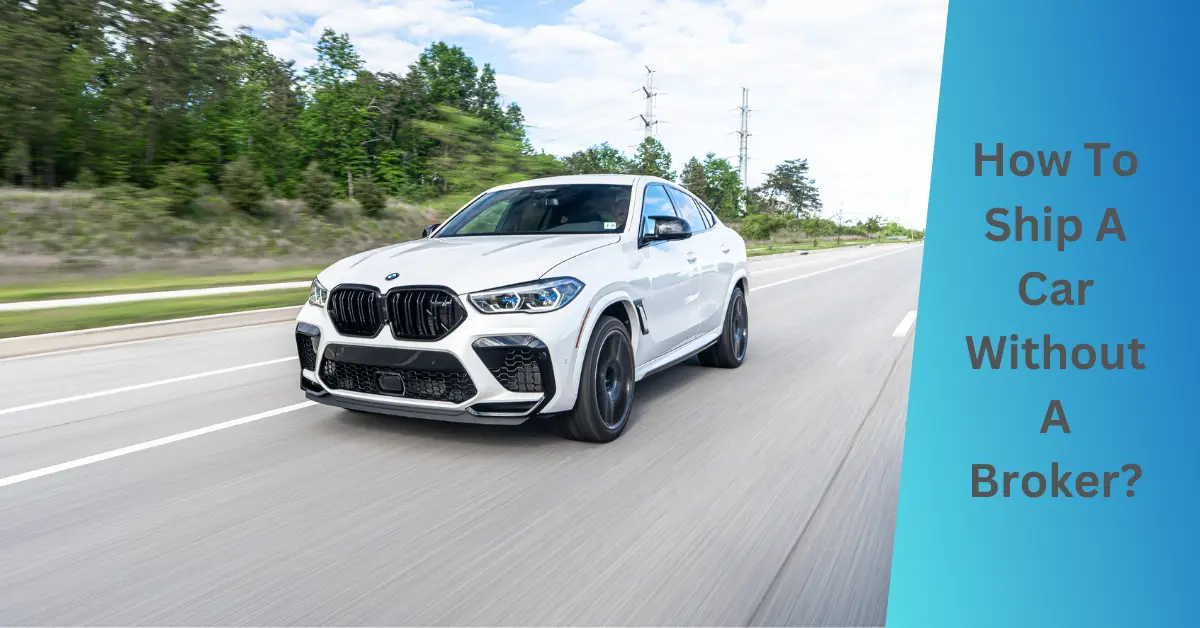Shipping your car can be challenging, primarily when you handle the process without a broker. Contrary to popular belief, auto transport carriers and not brokers can move vehicles directly , eliminating the need for intermediaries.
This guide simplifies that process by providing a detailed guide on how to ship a car without a brokerr, from choosing reputable carriers and booking transport arrangements to receiving your vehicle at its destination.
Interested? Let’s shift gears and start this journey together!
Key Takeaways
- Carriers and brokers do different jobs. Carriers are drivers that move your auto; brokers find reliable carriers.
- Look for good and bad things about a carrier before choosing one. You must check if they have all the needed rights to work.
- Clean your car, remove everything from the inside, and secure loose parts before shipping.
- Keep in touch with the carrier during transport. Make sure you know where your car is at all times.
- Please make time to look over your auto shipment once it arrives. If there’s damage, note it on a paper known as the Bill of Lading before signing off or making final payments.
Understanding Carriers vs. Brokers

Knowing the difference between carriers and brokers in auto shipping is crucial. A carrier directly ships your car, eliminating the middleman, while a broker facilitates the process by finding you a suitable carrier, often for an added fee.
Understand that each has pros and cons; auto carriers might be cheaper but need more effort, whereas brokers can save you time but could cost more. Decipher whether a company is a transport broker or automobile carrier to choose wisely per your needs and budget.
Difference between carriers and brokers
Carriers and brokers play different roles in automobile moving. A carrier owns trucks. They pick up your car and take it to where you want. A broker, on the other hand, does not own any trucks.
Brokers work as go-betweens for you and carriers. They hire a carrier who can move your car at a reasonable cost.
Benefits and drawbacks of using carriers
Some key advantages of using carriers.
- Using carriers to ship your car can give you more control.
- You get to talk directly to the people moving your automobile. This lets you know every step in the move. Shipping is often quicker, too.
But, only some carriers are good at their job, and some may need more reliable trucks.
- Costs can be lower with a carrier than a broker, but this is sometimes true. Sometimes, an auto carrier might charge more due to high demand or less competition.
- Speaking and working out details directly with the automobile carrier can also take longer than finding a broker who does most of the work for you.
Benefits and drawbacks of using brokers
Using a broker to ship your car has ups and downs.
- Brokers can reach many auto carriers. This helps them offer reasonable prices.
- They have no trucks or routes, so they are flexible.
- Reliable brokers are also insured, so the broker’s policy jumps in if an auto carrier’s insurance lacks coverage.
- Brokers have brick-and-mortar offices that you can visit in case of any problems; carriers are always on the road.
But there are problems, too.
- Their price is often higher than others. This is because they use many trucks and transport firms for your benefit.
Researching and Choosing a Carrier

Begin by determining whether a company is a transport broker or an automobile carrier. Then, start researching carriers in your vicinity and check each one’s credentials and reputation before you proceed with any decision-making process.
Obtaining quotes from multiple carriers to compare prices and services is also highly beneficial. This step will give you an overview of a fair price range, helping you pick the suitable carrier for your car moving needs.
How to Recognize if a Company is a Transport Broker or a Car Carrier?
Look for signs to tell if a company is a transport broker or a car carrier. A broker often has many links on its website to different carriers. They do not own trucks. They set up your car move with other companies.
Carriers, however, have the trucks they use for shipping cars. The name of the company is on their truck doors. You can also check the website of the Federal Motor Carrier Safety Administration (FMCSA).
This will tell you if they are an auto broker or carrier.
Researching carriers in your area
Start by making a list of carriers in your area. You can do this online or look at local phone books. Check their websites for details about the types of cars they ship and how far they go.
Look for ones that handle your kind of car and can get it to where you want it to go.
Next, check each carrier’s ratings and reviews online. Watch out for any nasty comments or low scores; these could be warning signs! Also, find some good pictures of the trucks they use.
Good photos show the company is proud of its work, which means they might take better care of your car when moving.
| Things to Consider When Researching Carriers |
|---|
| Reputation and customer reviews |
| Licensing and insurance |
| References |
| Specialization in your type of vehicle |
Checking carrier credentials and reputation
Make sure the carrier has a good name. Look for reviews from past customers. This will tell you if they did their job well. Also, check to see if they have the proper papers. They should have licenses and insurance coverage.
Remember USDOT credentials , too. This shows that they follow rules and laws by the government in moving cars safely.
Obtaining quotes from multiple carriers
Ask different carriers for their prices. This step is essential in your plan to ship a car. It lets you see the costs from each carrier. Make sure you ask many carriers, not just one or two.
More quotes give you better choices. It lets you find the best deal for moving your car without a broker. You save money this way since there are no added fees that brokers often charge.
Every dollar counts, and this step helps keep costs down while still getting quality service.
Booking Your Transport
Once you’ve chosen a reliable carrier, start making arrangements for your car’s transport. Be sure to fully understand the terms and conditions before solidifying your booking. It’s crucial to review every piece of paperwork carefully before signing off on anything.
Making arrangements and scheduling with the chosen carrier
Picking a suitable date is vital in shipping your car. Plan at least two weeks to give the carrier time to make space for your car. Talk with the carrier about dates that work best for both of you.
Now, it’s time to set up a pickup spot. Some carriers may not go into small streets, so you must meet them elsewhere. Always update them if there are any changes in your plans or address.
This will help avoid problems later on!
Understanding the terms and conditions of the transport
You must know what you’re saying yes to when moving your car. The terms and conditions tell you about the rules of transportation. These are put in a contract by the carrier. This contract discusses costs, pickup times, and how they handle problems.
Before signing anything, read it all very carefully. If there’s something you need help understanding, ask them to explain it to you in an easy way. Don’t feel rushed into signing anything that makes you uneasy.
It’s your car on the line, after all!

Signing the necessary paperwork
You need to sign some papers. One critical paper is the bill of lading. The car driver gives you this paper. It tells about your car and how it looks now. Make sure all details are correct before signing! Another critical point is about insurance.
Ask the carrier about their coverage before you sign anything. Do this even if taking out extra cover seems costly. This step will give you peace of mind while your car moves from one place to another.
Preparing Your Vehicle for Transport
Start by thoroughly cleaning your car to make it easier to spot any possible damage. Conduct a detailed inspection, taking time-stamped photos for reference. Remove all personal belongings from the car, as carriers are not liable for lost items.
If loose parts are in or on your vehicle, secure them correctly to prevent potential transport damage. Finally, turn off any alarms in your vehicle to avoid unnecessary interruptions during transit.
Cleaning and inspecting your car
Take the time to clean your car well before shipping. A clean car helps you see any scratches or dings. Make sure you note these down. Taking pictures of your car from all sides is also a good idea.
These photos should have a date and time on them.
Once the car is clean, do an in-depth check of your vehicle. Look for any damage that already exists. This makes it easy to pick out new damage if it happens during transit. Doing this step ensures there are no surprises later on when the carrier delivers your vehicle.
Removing personal belongings
You have to empty your car before moving it. This means taking out all personal stuff. The law says that cars used for shipping cannot carry any items inside them. All auto shipping firms follow this rule very closely.
So, remove everything from the car before you ship it off.
Securing loose parts and disabling alarms
Check your automobile for loose things. Take off antennas, spoilers, and mirrors that can be removed. Make sure all parts are tight and secure. This keeps your car safe while it is moved.
It also keeps other cars on the carrier safe from harm. Next, turn off any alarms in the car. Alarms can cause problems during the move if they go off by mistake.
Monitoring and Communicating with the Carrier
Keep tabs on your vehicle’s transport journey by communicating openly with the carrier, promptly addressing concerns, and confirming vital delivery details. Dive in for a comprehensive look at practical ways to manage this crucial phase of auto shipping.
Staying updated on the progress of the shipment
Tracking your car’s trip is vital. The carrier should keep you in the loop. This helps you know where your automobile is at all times. If there are any problems, you act fast.
Choose a carrier that talks to you often about the shipment. They need to be transparent and open with their words. This means no secrets about what’s happening with your auto-moving process.
Addressing any concerns or issues with the carrier
Speak up if you spot any problems during the auto move. You should let the carrier know right away. This helps fix issues fast and keeps your car safe. When dealing with a carrier directly, you have more control than a broker.
This means you can get fixes done quicker, too. Always keep track of what’s happening with your car transit. That way, any problems that come up can be handled at once.
Confirming delivery details and logistics
Talking with the driver about where and when your car will be delivered is essential. You need to give them precise details. For example, if your street is too narrow for a big truck, you may have to meet at a nearby parking lot.
Ensure this spot is easy to find and safe for both of you. Make sure they know when you want the car dropped off, too. This way, there are no mix-ups , and everything goes as planned.
Receiving Your Vehicle and Finalizing the Process
When your auto shipment arrives, inspect it carefully for any damage. Sign the Bill of Lading only once you confirm that the vehicle delivery is complete and in good condition. Lastly, settle the remaining payments or fees to finalize the shipping process with the carrier.
Inspecting your car upon arrival
Look at your car closely as soon as the shipment gets to you. Use the photos you took before the trip. Check for any new marks or dings on your car’s body. If it’s dark, use a flashlight.
If you see new problems, write them down on the Bill of Lading paper. The driver must sign this, too. Only make some payments once this is done well.
Signing the Bill of Lading and confirming delivery
You and the driver inspect the car together. You look over all parts of the exterior. The findings go on a form called the Bill of Lading.
This is not just any paper; it’s a legal contract for the auto shipment. Both you and the driver should sign this family document. It shows that your car has been moved safely and in good shape from one spot to another.
If there’s damage, write it down on the paper, too, before signing off.
Settling any remaining payments or fees
You must pay any leftover costs once the shipment is in transit. This could be with a credit card or other ways. If you use Easy Auto Ship, we only ask for money after the car moves.
Make sure to do this within 30 days of getting your auto shipment. If your shipment gets damaged during transport and can’t be fixed , the insurer will give you cash for its worth.
7 Tips For Vehicle Safety and Avoiding Getting Scammed When Dealing Directly With Carrier

- Watch out for scams. Some fake companies offer low prices to trap you. They may not have actual contact details on their website. Be smart and check the info well.
- Choose a carrier with good reviews. A proven track record with excellent reviews speaks volumes about the company’s service quality. Auto carriers with bad or no customer feedback may not be safe.
- Ask your carrier for all the needed details before shipping your car. If they deny giving it, watch out! Legit carriers will share their name, phone number, address, and logo upfront without hiding anything.
- Keep an eye on the transport progress of your vehicle regularly. Stay in touch with your carrier while they’re moving your car! The company should always keep you updated about where your vehicle is.
- Before you sign any paperwork, make sure you read it well. Understand what each term and condition means for your auto shipment exactly.
- Preparing and documenting your car correctly before sending the auto shipment off with a carrier is also critical. Give it a good clean and check all parts of it carefully. Take out any stuff that’s yours, like bags or CDs. Ensure nothing in the car is loose or could make noise during transport. Then, take many pictures and document its condition before it’s shipped off.
- Lastly, carefully check over your car when the shipment arrives at its destination before signing off on the auto shipment’s safe delivery. Match the automobile’s condition with the inspection report you prepared before shipping.
If some things seem wrong, act on those issues right away rather than waiting until later down the line!
Cost Analysis of Directly Using a Carrier vs. a Broker (Examples)
You can save money by using a carrier , not a broker. A direct line to the carrier often means lower costs. You don’t have to pay broker fees this way. But there are fewer choices. You get just one quote from the carrier.
On the other hand, brokers help you see many quotes at once. This makes it easy to pick the best price and service level. However, remember that brokers charge for their services, which could be anywhere from $150 to $200 or more.
This fee could hike up your total cost. However, the added safety is worth it, especially if you need more time to spend hours trying to find a reliable carrier or if your vehicle’s safety is important to you. Here are some reasons why:
Brokers have their own insurance coverage, so if the auto carrier’s coverage is insufficient, they can also use theirs.
Brokers are verified and licensed entities with brick-and-mortar locations. In case anything goes wrong, you can always walk into their office and get help directly. Carriers don’t have that; they’re always on the road.
Brokers have dedicated live chat support in case you have any queries before, during, or after the shipment is in transit. Carriers need more time to offer support; they drive trucks.
Brokers do their due diligence by carrying out background checks, insurance verification, and license checks before handing over their vehicles to carriers.
Brokers like Easy Auto Ship offer additional perks like a complimentary auto wash if the vehicle arrives dirty or funds for vehicle rental if the shipment is delayed; carriers typically do not offer such facilities.
| Aspect | Brokers | Carriers |
|---|---|---|
| Quotes and Pricing | Display multiple quotes | N/A (Provide their own quotes) |
| Cost | Service fee ($150 to $200 or more) | Carrier’s pricing |
| Insurance | Broker’s coverage | Carrier’s coverage |
| Accessibility | Physical locations for in-person help | On the road, less accessible |
| Customer Support | Live chat support, call support, sms support, email support and you can also walk into the office | Limited support due to driving |
| Due Diligence | Background checks, insurance verification, license checks | Limited due diligence |
| Additional Perks | Car wash, rental funds (e.g., Easy Auto Ship) | Limited other services from auto carriers |
The choice is yours - we’ve seen both methods work well!
FAQs
What does it mean to ship a car without a broker?
Shipping a car without a broker means using an auto carrier for your auto shipment, not going through an auto shipping broker.
How can I ship my car without using an auto shipment broker?
You need to find and make deals with the auto carrier directly for your vehicle shipment.
Does using an Auto Shipping Broker vs Carrier affect the cost of moving my car?
Yes, when you choose auto shipping broker vs carrier, brokers might add fees, which makes it more costly than shipping with just the carrier.
Are shipping a car without an Auto Shipment Broker risks?
Without an Auto shipment broker, you take on all responsibility in case of any issue during transit.





